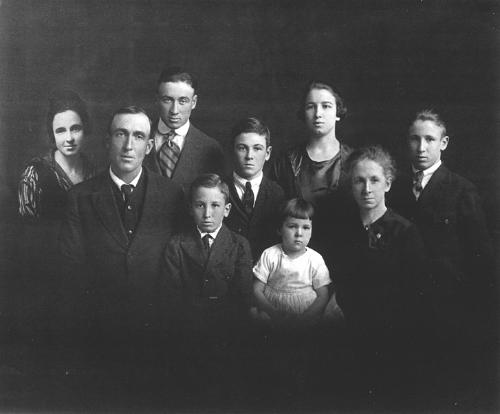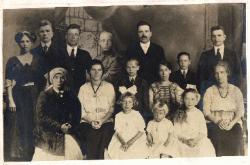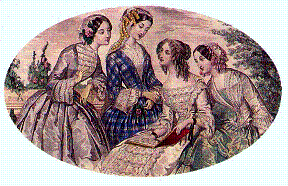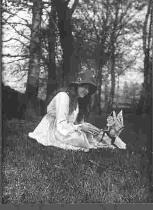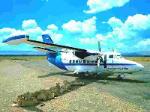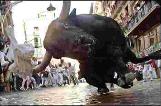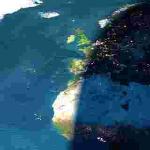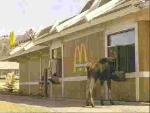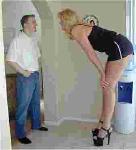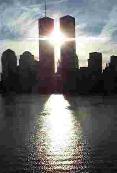
The winners of this quiz will receive a 10% discount on the purchase of a
Forensic Genealogy book. Please enter if you have already been a winner.
We honor multiple discounts!
Forensic Genealogy book. Please enter if you have already been a winner.
We honor multiple discounts!
| ******** |
| Quiz #51 - March 5, 2006 |
| What's wrong with this picture? |
| Thanks to Cathy Clark for submitting this picture. |
| ********** |
| Answer: The woman on the end in the back row was inserted into the picture later. |
Notes:
1. The shadows on her face are on the side opposite to those on the other faces.
2. The contrast of her picture is different than the rest of the family.
3. She has a thin white outline around her head.
4. Her picture is cut off at the chest.
5. Her picture is slightly smaller than the rest.
Possible additional clue:
She is smiling, while the others are solemn, perhaps indicating her picture was
taken on another occasion.
1. The shadows on her face are on the side opposite to those on the other faces.
2. The contrast of her picture is different than the rest of the family.
3. She has a thin white outline around her head.
4. Her picture is cut off at the chest.
5. Her picture is slightly smaller than the rest.
Possible additional clue:
She is smiling, while the others are solemn, perhaps indicating her picture was
taken on another occasion.
| ********** |
The picture is of George Clark and his family, taken in Kearney, Nebraska
about 1919. His daughter Millie, shown on the left in the back row, died in
childbirth at 18 years of age shortly before the photograph was taken. The family
left room for her on the end, and inserted her graduation picture later so the
whole family could all be seen together.
From left to right:
Millie, 18 yrs, d. 1919
George Clark, d. 1950
Rolland, 21 yrs
Lester, 15 yrs, d. Long Beach, CA 1935
Sadie/Sallie/Sarah, 19 yrs
Ray, 16 yrs
Glen, 13 yrs, d. Santa Rosa, CA 1963
Dorothy, 3 yrs, d. August 1925 aged 9 yrs and 9 mos
Dora Jane (Trollope) Clark, d. 1938 62 yrs
about 1919. His daughter Millie, shown on the left in the back row, died in
childbirth at 18 years of age shortly before the photograph was taken. The family
left room for her on the end, and inserted her graduation picture later so the
whole family could all be seen together.
From left to right:
Millie, 18 yrs, d. 1919
George Clark, d. 1950
Rolland, 21 yrs
Lester, 15 yrs, d. Long Beach, CA 1935
Sadie/Sallie/Sarah, 19 yrs
Ray, 16 yrs
Glen, 13 yrs, d. Santa Rosa, CA 1963
Dorothy, 3 yrs, d. August 1925 aged 9 yrs and 9 mos
Dora Jane (Trollope) Clark, d. 1938 62 yrs
| ********** |
| Photos and Comments from Our Readers |
We received some very interesting pictures and comments about "faked" photos and
photo montages from our readers. Eva Royal, one of our quizmasters, submitted her
own step-by-step quide for creating your own photo compositions using popular
software packages. See examples of Eva's work below. There is a link to her
instructions below the examples she sent us.
photo montages from our readers. Eva Royal, one of our quizmasters, submitted her
own step-by-step quide for creating your own photo compositions using popular
software packages. See examples of Eva's work below. There is a link to her
instructions below the examples she sent us.
John Chulick
The reason I caught the added woman was
the attached photo. How many added
persons do you see?
I have no idea where it was taken but
suspect it was somewhere in Europe. I
also can't name a single person in the
photo. It was with all of the family photos
The reason I caught the added woman was
the attached photo. How many added
persons do you see?
I have no idea where it was taken but
suspect it was somewhere in Europe. I
also can't name a single person in the
photo. It was with all of the family photos
that belonged to my parents. Our ancestors came from Galicia and from Banat (both
areas of Austria-Hungary) and immigrated here between 1903 and 1910. Do the people
look like Ukrainians or Serbians?
I suspect adding people was fairly common at one time. Maybe now with digital
editing it will come back into vogue.
areas of Austria-Hungary) and immigrated here between 1903 and 1910. Do the people
look like Ukrainians or Serbians?
I suspect adding people was fairly common at one time. Maybe now with digital
editing it will come back into vogue.
Mary Fraser
I have to share something silly with this. My
older daughter and her best friends have a
“shtick” that’s been going on since college.
WHENEVER they have a picture taken, they
all deliberately look in different directions, so
you definitely can’t go by that- as I have
firsthand experience! (see attached- my
daughter is the bride).
Pat Snyder
Oddly enough I have such a picture. A "photo" of my great great great grandfather,
John Shepard. While in the frame it is not quite as obvious as when out of the frame,
but once you see it, it is obvious that it is a composite of a drawing and a photo, with
the man's signature cut from a letter added in.
Eva Royal
Oddly enough I have such a picture. A "photo" of my great great great grandfather,
John Shepard. While in the frame it is not quite as obvious as when out of the frame,
but once you see it, it is obvious that it is a composite of a drawing and a photo, with
the man's signature cut from a letter added in.
Eva Royal
| Original Picture |
| Eva's Photomontage |
To read Eva's step-by-step instructions for creating your own photomontage, click here.
| ********** |
| Photo Fakery |
Until recently, most fake photos were created using conventional darkroom techniques.
But with the advent of the digital camera and computer photo manipulation software
packages, fake photos are now frequently generated electronically.
All a digital photo really consists of is an array of numbers, each number indicating the
relative amount of light that has illuminated a pixel of the camera. (Hence the name
digital camera). The higher the number, the greater the amount of light associated with
its pixel. Theoretically, a digital photo could be doctored by changing the value of
different pixels, but this would be a very time-consuming task, considering the most
popular digital cameras used at present have at least 3 megapixels (3 million pixels). For
this reason, fake photographs are still created using conventional methods by either
manipulating the context of the photo or by changing its content.
There are many well-known photos in each category.
Change in Context
But with the advent of the digital camera and computer photo manipulation software
packages, fake photos are now frequently generated electronically.
All a digital photo really consists of is an array of numbers, each number indicating the
relative amount of light that has illuminated a pixel of the camera. (Hence the name
digital camera). The higher the number, the greater the amount of light associated with
its pixel. Theoretically, a digital photo could be doctored by changing the value of
different pixels, but this would be a very time-consuming task, considering the most
popular digital cameras used at present have at least 3 megapixels (3 million pixels). For
this reason, fake photographs are still created using conventional methods by either
manipulating the context of the photo or by changing its content.
There are many well-known photos in each category.
Change in Context
A photograph that has been faked by a change in context
can be hard to detect, since it has not been physically or
digitally doctored in any way. Perhaps the most striking
example of this is the famous photo produced in 1934
that was claimed to be of the Loch Ness Monster. It
was not until 1993 that the photo was discovered to
have been created with a piece of plastic wood fit over
the conning tower of a toy submarine. The lack of
perspective disguised the true dimensions of the object in
the water. Although the "experts" claimed the neck of
the monster was three feet high, it was only 8" in length.
A second famous example of photos that were faked by
changing their context was that of the Cottingsley
fairies. In 1917 Elsie Wright and her 10 year old cousin
Frances Griffiths claimed to have taken photos of
dancing fairies near their home. The photos were
examined by noted photographic experts who judged
them authentic because they saw no evidence of double
exposure nor evidence that the negatives had been
altered. Even Sir Author Conan Doyle, creator of
Sherlock Holmes, was convinced that the photos were
genuine.
There are telltale hints that the photos are not what they
are claimed to be. For example, although the shutter
speed was slow enough that the waterfall is blurred in
the background, the fairies in the first photograph are
sharp and do not appear to be moving. Even though in
1978 it was found the fairies were from the 1915 book
Princess Mary's Gift Book by Arthur Shepperson, the
truth was not revealed until 1981, when the aging
women confessed that the pictures of the fairies were
nothing more than paper cutouts held in place by tacks.
Change in Content
The content of a photo can be changed in a variety of
ways to create an illusion. Photomontages like this
can be hard to detect, since it has not been physically or
digitally doctored in any way. Perhaps the most striking
example of this is the famous photo produced in 1934
that was claimed to be of the Loch Ness Monster. It
was not until 1993 that the photo was discovered to
have been created with a piece of plastic wood fit over
the conning tower of a toy submarine. The lack of
perspective disguised the true dimensions of the object in
the water. Although the "experts" claimed the neck of
the monster was three feet high, it was only 8" in length.
A second famous example of photos that were faked by
changing their context was that of the Cottingsley
fairies. In 1917 Elsie Wright and her 10 year old cousin
Frances Griffiths claimed to have taken photos of
dancing fairies near their home. The photos were
examined by noted photographic experts who judged
them authentic because they saw no evidence of double
exposure nor evidence that the negatives had been
altered. Even Sir Author Conan Doyle, creator of
Sherlock Holmes, was convinced that the photos were
genuine.
There are telltale hints that the photos are not what they
are claimed to be. For example, although the shutter
speed was slow enough that the waterfall is blurred in
the background, the fairies in the first photograph are
sharp and do not appear to be moving. Even though in
1978 it was found the fairies were from the 1915 book
Princess Mary's Gift Book by Arthur Shepperson, the
truth was not revealed until 1981, when the aging
women confessed that the pictures of the fairies were
nothing more than paper cutouts held in place by tacks.
Change in Content
The content of a photo can be changed in a variety of
ways to create an illusion. Photomontages like this
week's quiz photo fall into this category The most common ways of changing the
context of a photo are (1) composite photos where multiple images are combined to
make a single print, (2) multiple exposures where a conventional negative is exposed
multiple times, and (3) photo collages where pieces of various photos are physically cut
out and pasted together to create a single composition, which in turn can be
photographed. (See http://www.photography-museum.com/phofictionsmontages.html).
context of a photo are (1) composite photos where multiple images are combined to
make a single print, (2) multiple exposures where a conventional negative is exposed
multiple times, and (3) photo collages where pieces of various photos are physically cut
out and pasted together to create a single composition, which in turn can be
photographed. (See http://www.photography-museum.com/phofictionsmontages.html).
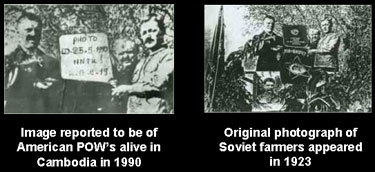
A well known example where the contents of a photo were altered to create a fake is
that of a group of three American POWs that supposedly shown to be alive in Cambodia
in 1990. Eight families claimed to identify one of the men as a missing family member.
It was subsequently discovered that the photo had appeared in a 1989 Khmer-language
edition of the magazine Soviet Life. It is a photo of three Soviet farmers during the
Stalin era celebrating a record harvest.The photo of the POWs was probably created as
a photo collage and then rephotographed.
How to Identify a Fake Photo
A fake photo that is created by changing its context is the hardest to spot, as it depends
on interpretation and not on any physical alteration of an original. Many photographs of
UFOs fall into this category - by definition they are photographs of unidentified objects
that are open to judgment.
A rule of thumb in spotting a faked photograph is to notice something "is not quite
right".The lighting, the contrast, the perspective, the size, and even the "noisiness" of
the altered part of a photo are usually impossible to adjust simultaneously to match the
original content. Many of our readers submitted the correct answer to the quiz based on
their intuition alone. Many others pointed out the discrepancies in lighting, size, and
contrast between the woman on the end in the back row and the rest of the family
members.
that of a group of three American POWs that supposedly shown to be alive in Cambodia
in 1990. Eight families claimed to identify one of the men as a missing family member.
It was subsequently discovered that the photo had appeared in a 1989 Khmer-language
edition of the magazine Soviet Life. It is a photo of three Soviet farmers during the
Stalin era celebrating a record harvest.The photo of the POWs was probably created as
a photo collage and then rephotographed.
How to Identify a Fake Photo
A fake photo that is created by changing its context is the hardest to spot, as it depends
on interpretation and not on any physical alteration of an original. Many photographs of
UFOs fall into this category - by definition they are photographs of unidentified objects
that are open to judgment.
A rule of thumb in spotting a faked photograph is to notice something "is not quite
right".The lighting, the contrast, the perspective, the size, and even the "noisiness" of
the altered part of a photo are usually impossible to adjust simultaneously to match the
original content. Many of our readers submitted the correct answer to the quiz based on
their intuition alone. Many others pointed out the discrepancies in lighting, size, and
contrast between the woman on the end in the back row and the rest of the family
members.
Sometimes, the content of a doctored photo is the first tip
that something is not right, as in this picture of the giant cat.
If the cat were really that big, the man would be leaning
backwards to support its weight.
Another example is this picture supposedly of the 2004
tsunami as it crashed onto the island of Phuket in Thailand.
It was widely circulated on the Internet. There are many
features of the picture that are "not right". One of the most
objective is that the direction of the traffic flow is wrong.
Drivers in Thailand drive on the left side of the road.
Another feature of the photo that proves it's a fake is that
the skyline is not that of Phuket. It is the skyline of
Antofagasta, Chile
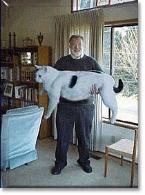
| Bring on the giant mice! http://oemagazine.com/fromthemagazine/ja n05/photofakery.html |

Tsunami waves are only four or five feet tall,
not several stories as this photo indicates. The
skyline is really that of Antofagasto, Chile.
See http://www.snopes.com/photos/tsunami/satellite.asp
not several stories as this photo indicates. The
skyline is really that of Antofagasto, Chile.
See http://www.snopes.com/photos/tsunami/satellite.asp
| ********** |
| A Photoquiz within a Photoquiz Can you spot the fakes? |
Four of the following photos are fakes. Can you spot which ones? Many were taken
from http://www.snopes.com/photos. The answers are given below the list of winners
at the bottom of this page. Don't peak before you give it a try!
from http://www.snopes.com/photos. The answers are given below the list of winners
at the bottom of this page. Don't peak before you give it a try!
| Click on thumbnail to see larger image. |
| 2. Bullshot |
| 1. Lion Around |
| 3. Blackout of 2003 |
| 5. Forest Fire |
| 6. McMoose |
| 4. Day and Night |
| 7. Jaws |
| 8. Poor Deer! |
| 9. High Heels |
| 10. Sunrise over the World Trade Center |
| ******** |
| Congratulations to our Winners! Special Recognition goes to Mr Rick's ESE Class, 2006 Mary Fraser Grace Hertz Dale Niesen Patrick Carney John Chulick Mary South Don Schulteis Richard Cleaveland Emily Rusk Bobbie Sims Carol Haueter Gena Ortega Pegeen Soare Tane Burke Rice MacKinney Bill Utterback David LePitre Debbie Sterbinsky Steve Zalewski Suzan Farris Patty Kaliher Peter St. Wecker Kelly Fetherlin Eva Royal Diane Rogers Stan Read Misty Bogle Carol Epp Judy Pfaff Sharon Seargent Ellis Nienhaus |
| If you enjoy our quizzes, don't forget to order our book! Click here. |
If you have a picture you'd like us to feature a picture in a future quiz, please
email it to us at CFitzp@aol.com. If we use it, you will receive a free analysis of
your picture. You will also receive a free Forensic Genealogy CD or a 10%
discount towards the purchase of the Forensic Genealogy book.
email it to us at CFitzp@aol.com. If we use it, you will receive a free analysis of
your picture. You will also receive a free Forensic Genealogy CD or a 10%
discount towards the purchase of the Forensic Genealogy book.
| ******** |
Answers:
The fake photos are #3, 4, 7, and 9.
1. http://www.snopes.com/photos/animals/lionplane.asp
2. http://www.snopes.com/photos/animals/bullshot.asp
3. http://www.snopes.com/photos/blackout.asp
4. http://www.snopes.com/photos/sunset.asp
5. http://www.snopes.com/photos/deerfire.asp
6. http://www.snopes.com/photos/animals/mcmoose.asp
7. http://oemagazine.com/fromthemagazine/jan05/photofakery.html
8. http://www.snopes.com/photos/animals/gatordeer.asp
9. http://www.snopes.com/photos/tallwoman.asp
10. http://www.snopes.com/photos/sunrise.asp
The fake photos are #3, 4, 7, and 9.
1. http://www.snopes.com/photos/animals/lionplane.asp
2. http://www.snopes.com/photos/animals/bullshot.asp
3. http://www.snopes.com/photos/blackout.asp
4. http://www.snopes.com/photos/sunset.asp
5. http://www.snopes.com/photos/deerfire.asp
6. http://www.snopes.com/photos/animals/mcmoose.asp
7. http://oemagazine.com/fromthemagazine/jan05/photofakery.html
8. http://www.snopes.com/photos/animals/gatordeer.asp
9. http://www.snopes.com/photos/tallwoman.asp
10. http://www.snopes.com/photos/sunrise.asp

| Contest #51 Results |
